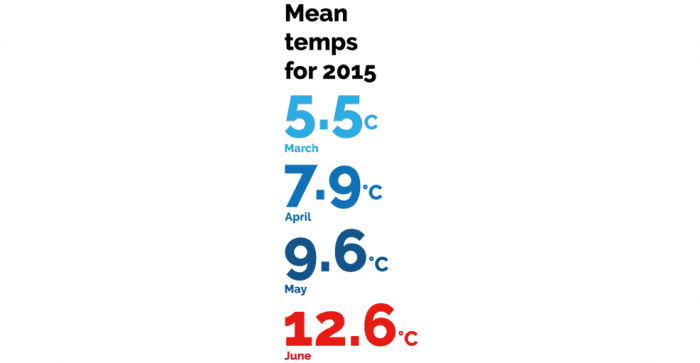Back in 2015, we wrote an article for Koi Carp Magazine explaining the impact weather has on a koi pond in winter. Here it is –
Winters in the UK are rapidly warming up! The average temperature in December daytime in the UK is a balmy 8°C and January isn’t much colder- so, it’s fair to say extremely cold winter months are a thing of the past as things stand.
Plants are blooming months earlier than they should, insects don’t know whether to hibernate or pollinate, and ponds completely freezing seem to be less common. It’s almost as though the differences between the seasons are becoming indistinguishable.
But what effect will this have on your pond’s biological balance when the ‘real’ spring arrives?
Check out our comprehensive guide full of expert advice below to find out!
The natural state of your koi pond
Your pond is naturally full of organic matter that will decay, whether it’s the twigs from overhanging trees, unwelcome pigeon droppings, or your beloved koi’s bodily functions.
This process of decay introduces substances such as phosphorous, ammonia, and hydrogen sulphide into the pond. Small amounts are fine – in fact, they’re normal, but, too much can easily affect pond water quality and the health of your fish.
We call this the “organic loading” of a pond. The more organics, the more decay, and the more adverse effects on water quality.
This is the essence of most water problems for pond owners. If the pond’s biological balance is out of kilter, you open the door for excessive amounts of ammonia, nitrites, phosphates, urea, faecal matter, and dead organic waste.
Therefore most owners use various pond treatments to tackle this issue by introducing task-specific ‘good’ bacteria into the pond environment.
The reduction in these contaminants improves the quality of the water and combats a wide range of aquatic pathogens and diseases that are harmful to koi, such as:
- Streptococcus
- Pseudomonas
- Aeromonas
- Vibrio
- Burkholderia
In essence, beneficial bacteria tackle the ‘bad’ bacteria that are effectively feeding off the organic matter in the pond, stopping future issues before they can occur.
Are milder winters more beneficial for your pond?
Surely a mild winter is good for our pond and it will lead to fewer adverse effects in Spring?
Well perhaps not, as this is where the answer gets a little muddy – pun very much intended. Winters are becoming very different, with the average temperature for December being a fairly high 8°C. This contrasts with traditional averages from years gone by, which hovered between 2-7°C and frequently dropped below freezing.
Organic matter decays in temperatures as low as 6-7°C, which means typical winter pond maintenance in the past involved fewer tasks as the pond becomes almost dormant, so it could be virtually left alone.
But, our more recent milder winters provide the ideal temperature for organic matter to decay without competition, creating sludge build-ups that transform your entire pond into an anaerobic environment that emits toxic gases, such as hydrogen sulphide.
Hydrogen sulphide can have fatal effects on aquatic life, including your precious pond fish.
To add insult to injury, we are now starting to experience storm-like conditions with heavy rain and wind during the winter months. Gale force winds have distributed a veritable smorgasbord of organic detritus around our gardens – some of which will have inevitably found a home in your pond!
High levels of rainwater, packed full of nutrients such as sulphur (think acid rain) and minerals, provide a readily available supply of nutrients to help organic matter decay.
The ‘bad’ bacteria in the pond thrive off this free buffet of nutrients, which only speeds up the decaying process and helps generate sludge.
So, in essence, we have the makings of a perfect storm. Lots of organics and nutrients finding their way into ponds, mild temperatures of around 8°C aiding decay, and traditional pond treatments that are only effective from above 10-12°C.
This is why you can expect to see some real problems when spring eventually starts.

Have pond treatments kept up with our evolving climate?
New strains of bacteria can be discovered in naturally occurring environments or be genetically modified to help better pond treatments.
But, in many ways, it’s a game of chance, as thousands of strains can be examined without finding anything that can improve on the strains we already have. This means it can be a big deal when a new strain is discovered.

In late 2013, however, a strain of bacteria was sampled in a stream in Pennsylvania. It was catalogued and its characteristics showed signs of very good activity at lower temperatures.
The bacteria showed the same activity at 4°C as similar bacteria do at 10-12°C and as it was found in an aquatic natural environment, it is incredibly well-suited to be used as a bacterial-based pond water treatment – and it was patented!
What does this mean for your koi pond?
This new strain of bacteria is great news for koi pond enthusiasts in the UK.
The bacteria don’t stop clearing
This activity at 4°C means that the bacteria will keep clearing its food sources in the same stable and continued manner, even during temperature spikes.
So, instead of the bacteria stopping if temperatures drop below 10°C and then springing into action at the end of winter when the warmer weather returns and raises the water temperature in our ponds to around10-12°C.
The bacteria continue to concentrate on digesting organic matter rather than wasting energy stopping and starting due to temperature fluctuations – which makes them much less effective, too.
The bacteria are more reliable
These new low-temperature strains look to be the ideal answer for easy pond maintenance as they provide you with more constant and reliable bacterial activity much earlier in the year – to tackle the inevitable build-up of organic matter that the warmer and wetter winters are bringing.
Envii’s range of bacterial pond products incorporates the unique patent-pending bacterial strains that are fully active at temperatures as low as 4°C – keeping your pond environment and koi fish healthy.
So, why not invest in a bacterial pond treatment today to ensure your spring pond maintenance is less intense?
Essential tips for maintaining your koi pond in winter
As well as investing in more effective and consistent bacterial pond products, what else can you do to ensure your koi fish survive winter and reduce the impact of green water, sludge, and other algae problems come spring?
Physically removing as much sludge and organic matter from your pond
Part of your koi pond winter care is to get rid of sludge and organic debris from the bottom of the pond – you can do this with a net, bucket, pond vacuum, or even your bare hands. We recommend using a finer net to catch the smaller particles floating in the midwater.
Also, don’t forget to remove any blanket weed or floating organic matter such as leaves from the water surface using a net or rake.
Keep your pond filters clean
Filters and air pumps help to ensure the well-being of your pond by removing organic waste and algae.
Keeping your pond filter clean is vital so you can catch as many organics in the water column as possible – this is especially essential if your pond water temperature stays milder than expected and there’s more debris in your pond this winter.
Add pond plants to your koi pond
Try introducing pond plants to your pond’s ecosystem. Naturally, the plants will absorb a lot of the bad nutrients and gases, such as carbon dioxide, and help to inject oxygen into the water.
Add plenty of task-specific bacteria at the start of spring
Providing the bacteria in question is safe in large amounts, add a double or triple dose for the first few times in spring. Task-specific beneficial bacteria digest the organics that will have accumulated over the autumn and winter months.
Bacteria grow logarithmically – 1 becomes 2, 2 becomes 4, 4 becomes 8 etc. So, the more you add the quicker the results.
Avoid adding materials that nourish ‘bad’ bacteria
The last thing you want to do is add nutrients that feed bad bacteria into your natural pond. Such materials may include plant fertiliser, which may run into your pond accidentally.
Monitor your water temperature
You must keep an eye on the temperature of your pond throughout winter and ensure your pond heater (if you have one) is set at the correct temperature.
You may even realise you don’t need your pond heater as high during the milder winter weather. However, if water temperatures drop, you can easily adjust the settings.
Feed koi less during winter
Although not as dramatically as we’re used to, the water temperature still drops during the colder months. During this time (if temperatures drop below 10°C), your fish’s digestive systems almost shut down, so you should stop feeding your pond fish during the winter as they can no longer digest food.
If you add food to your pond at this point, it will simply start to decay and contribute to the sludge deposits that you want to avoid.
Get in touch
Keeping your koi pond healthy this winter is made super easy thanks to our treatments, which are super effective, even during winter.
Our experts are on hand to advise and offer guidance about winter koi pond care and our range of pond treatments. If you’d like to know more, call us today on 0124 624 0880 or email us at info@envii.co.uk.

 Call us on 01246 240880
Call us on 01246 240880 Free 48hr Delivery
Free 48hr Delivery Sign-up and receive 10% off
Sign-up and receive 10% off